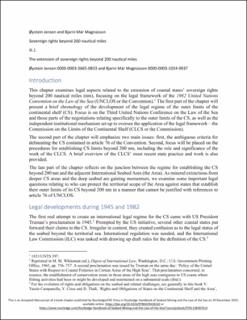The Extension of Sovereign Rights Beyond 200 Nautical Miles
| dc.contributor.author | Jensen, Øystein | |
| dc.contributor.author | Magnusson, Bjarni Mar | |
| dc.date.accessioned | 2024-03-22T13:45:28Z | |
| dc.date.available | 2024-03-22T13:45:28Z | |
| dc.date.created | 2024-01-05T12:39:20Z | |
| dc.date.issued | 2023 | |
| dc.identifier.isbn | 9780429426162 | |
| dc.identifier.isbn | 978-1-032-61333-8 | |
| dc.identifier.uri | https://hdl.handle.net/11250/3123902 | |
| dc.description.abstract | This chapter examines legal aspects related to the extension of coastal states’ sovereign rights beyond 200 nautical miles, focusing on the legal framework of the 1982 United Nations Convention on the Law of the Sea. The First United Nations Conference on the Law of the Sea adopted the Convention on the Continental Shelf in 1958.4 However, it became clear that this treaty was unable to balance considerations arising from international politics over the course of the 1960s. Thus, it defines the outer limits of the CS by a vague criterion, entailing the risk of coastal states ‘grabbing’ seabed areas. The language of this provision is open to several possible interpretations, of which the most extreme – resting solely on the exploitability criterion – would ultimately permit all submarine areas to be claimed by coastal states. | en_US |
| dc.language.iso | eng | en_US |
| dc.publisher | Routledge | en_US |
| dc.relation.ispartof | Routledge Handbook of Seabed Mining and the Law of the Sea | |
| dc.title | The Extension of Sovereign Rights Beyond 200 Nautical Miles | en_US |
| dc.type | Chapter | en_US |
| dc.type | Peer reviewed | en_US |
| dc.description.version | acceptedVersion | en_US |
| cristin.ispublished | true | |
| cristin.fulltext | postprint | |
| cristin.qualitycode | 2 | |
| dc.identifier.doi | https://doi.org/10.4324/9780429426162 | |
| dc.identifier.cristin | 2221380 |
Tilhørende fil(er)
Denne innførselen finnes i følgende samling(er)
-
Publikasjoner fra Cristin [3269]
-
SAM - Handelshøyskolen [392]
SAM - Oslo Business School
